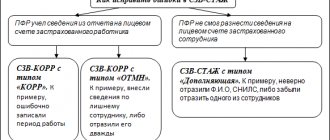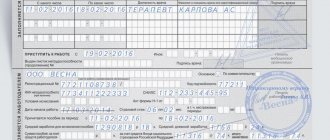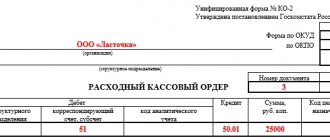If you discover an error in your financial statements and correct it, how you present the corrected balance sheet depends on who you send the corrected copy to.
If the updated balance needs to be submitted to the Federal Tax Service, you need to correctly fill out the same forms and enter the adjustment number in the financial statements.
To submit accounting statements, the founders need to prepare an explanatory note in addition to the balance sheet. The explanatory note must indicate the nature of the identified error, the amount of deviations, and the method of correction.
What are the errors?
Errors in accounting statements discovered in later periods are subject to correction.
The procedure for correcting them is regulated by PBU 22/2010, approved. by order of the Ministry of Finance of the Russian Federation dated June 28, 2010 No. 63n. This document contains information about what errors in accounting and reporting can be and the reasons for their occurrence. Non-reflection or incorrect reflection of the facts of economic activity arises due to ignorance or incorrect application of legislation, lack of information at the date of approval of the report and dishonest actions of officials. PBU 22/2010 classifies errors of previous periods identified in the reporting period into significant and insignificant.
Materiality is determined by the organization independently. The main criterion is the degree of influence of unaccounted or incorrectly reflected business transactions on the annual financial result. The significance of the financial result is taken into account by the founders, investors, counterparties and other persons whose interaction is important for the company.
IMPORTANT!
Gaps in the reflection of facts of economic activity, identified as a result of obtaining new information that was not available at the time of reflection of such facts, according to PBU 22/2010, are not errors. In this regard, the question arises: whether the untimely receipt of documents in the accounting department is included in this definition. The answer is negative, since the deadlines for receiving documents from counterparties are approved by the company’s internal document flow, defining the list of persons responsible for the timely submission of primary documents to the accounting department.
The main mistakes in accounting work
Let's start with the fact that an accounting error is the entry into documents of unreliable information about the economic or financial activities of an enterprise. Inaccurate calculations can be caused by an incorrect assessment of factors, ignorance or incorrect application of the current norms of Russian legislation. In some cases, we are talking about malicious intent. Let's look at mistakes that are typical for any accountant.
Salary payment
Let us immediately note that in most cases, the cashier of the enterprise is in charge of issuing wages, however, the accounting documentation is prepared by the accounting department.
This is where employees should contact if they discover any inaccuracies in their due payments. Let's look at typical errors:
- Failure to comply with labor legislation - failure to pay overtime, bonuses and other required allowances;
- Incorrect calculation of travel allowances - in particular, the accountant confuses the average daily and average monthly earnings;
- Violation of the procedure for calculating dismissed employees - for example, the payroll period is incorrectly taken into account or deductions are made that are not provided for by the norms of the Labor Code of the Russian Federation;
- Failure to comply with the deadlines for accruing salaries to employees - according to the law, wages must be paid twice a month;
- Overpayments - an employee is paid a larger amount than expected;
- Incorrect withholding - more than 70% of payments due to an employee cannot be withheld.
Depending on the situation, the accountant may be subject to disciplinary, administrative and criminal liability.
Accounting errors
Such errors do not affect the interests of employees, but the financial and economic activities of the organization as a whole. Such errors are classified into 2 main types:
- Technical. This may include any inaccuracies made when filling out the reporting documentation. For example, typos were made that distorted real facts, negative indicators were incorrectly highlighted, fields were left blank;
- Methodological. This group includes errors made when filling out primary documentation or displaying business transactions. For example, the necessary details are missing, the amounts and posting dates are incorrectly indicated, and the methods for valuing property on the company’s balance sheet are incorrectly applied.
Such errors are eliminated by making corrections to the reporting documentation with mandatory explanations in the annual reporting. The explanations indicate the nature of the error and the adjustment amounts for each item of the submitted report.
How do they affect current reporting?
If incorrect maintenance of the accounting register is long-term and continues in the current period, then the degree of materiality will change. For example, in November equipment was accepted for accounting, and the depreciation group was incorrectly determined. As a result, depreciation was calculated incorrectly starting in December last year. Since the incorrect amount of depreciation was accrued only for one month of the previous period, this is an insignificant error of the previous reporting year that was discovered after the reporting date. If an accountant discovers an inaccuracy at the beginning of the year, then it is enough to make a corrective operation by issuing an accounting certificate dated January 1 of the current year. If depreciation has been calculated incorrectly all year, the error will be material and will significantly impact the financial result.
ConsultantPlus experts looked at how to take into account the correction of an error that led to excessive payment of wages. Use these instructions for free.
to read.
Dividends of participants, bank decisions on issuing loans and other important aspects of the economic life of the enterprise depend on the financial result. In this regard, significant errors of previous years in the financial statements that change the indicators of retained profit or loss are subject to correction with the subsequent provision of a corrected copy of the statements to interested parties.
Incorrect deduction of debt from an employee's salary
Very often mistakes are made related to the incorrect deduction of debt from the wages of an employee who is a debtor, by order of a bailiff. They boil down to the following:
- deduction of debt prior to withholding of income taxes;
- failure to send a quarterly report on deductions to the FSSP;
- untimely return of documents upon termination of withholding;
- late transfer of money.
The reason for errors often lies not only in the inexperience of the accountant. The fact is that the current legislation does not contain all the retention rules, but only part of them. The rest are in by-laws and decisions of the Supreme and Constitutional Courts.
Violations may result in the accountant being held administratively liable and required to pay a hefty fine.
How to fix
The procedure for correcting data depends on when the inaccuracy was made and discovered.
Errors made and discovered in the same reporting period
If the accountant discovers in the current year that some data is not reflected or reflected incorrectly, the business transaction should be adjusted to the date when this transaction was made. In some cases, this is problematic, since correcting data retroactively entails the need to restore the sequence of business transactions in the accounting program. For large volumes of data or in cases where an error in the reporting period is classified as insignificant, adjustment is allowed by the date the error was discovered, the beginning of the current month or quarter. The data is corrected in any of the following ways:
- execution of a corrective accounting certificate by the date of discovery of the inaccuracy, the beginning of the current month or quarter;
- red reversal method. An incorrectly completed transaction is reversed (i.e., duplicated with a minus sign), and a transaction with the correct data is issued in return.
Errors made and discovered in different periods
Section II of PBU 22/2010 describes in detail the procedure for correcting errors in accounting and reporting for past periods. The basic rules are as follows:
- If an error is discovered before the date the reports are signed by the manager or before they are submitted to interested parties (founders, authorities, etc.), corrections should be made at the end of the period for which the reports are submitted.
- If incorrect data has already been transmitted to interested parties and submitted to the tax authority, corrected reporting should be provided.
- In many reporting forms (for example, balance sheet, profit and loss statement, etc.), columns with data for previous periods are filled in. If adjustments were made, you should fill in the data that was available before the inaccuracy was discovered.
| When invalid data is detected | Procedure |
| Before signing by the manager | Correct the data with the date December 31 and sign again |
| After approval and provision to participants and the Federal Tax Service, but before the reporting date | Correct the data with the date December 31, re-sign and provide the corrected report to interested parties |
| After the reporting date | Correct the data for the current period, reflecting in the accounting the profits (losses) of previous years identified in the reporting period |
An example of correcting financial statements for previous years
On March 25, the report, approved by the manager, but not provided to the Federal Tax Service and interested parties, incorrectly reflected the debt to the supplier. The legally established deadline for approval and submission of the report is March 31. The accountant makes an adjusting entry dated December 31 of the previous year and prepares a new statement with the correct amount.
The question may arise: how are corrected financial statements prepared and are there adjustment numbers similar to tax returns? There is no indication of an adjustment in the financial statements. If inaccurate data is found after corrections are made, a new copy of the report is simply compiled.
Basic ways to fix errors
Here it is possible to use 3 methods that are suitable for most accounting documentation. It looks like this:
- Adjustment. Suitable for paper reports and statements. If there is an inaccuracy when filling out, the error is crossed out so that the incorrect inscription remains readable. The notes include the date of the corrections, the data and signature of the responsible person, and the seal of the organization;
- Additional wiring. It is used in case of untimely detection of amounts or previously made errors. In these cases, a new entry is drawn up for the amount of the shortage or overpayment;
- Red reversal. Applies to correcting inaccuracies in accounts. In this case, errors are marked in red ink and these amounts are deducted from the entry.
Read also: Indexation of alimony
It should be clarified that not all accounting documentation is subject to correction. In particular, you cannot correct errors in cash and banking documents.
Why and how can an accountant be punished?
An accountant generally has to answer a lot and often. five types of responsibilities for this profession :
- Disciplinary
- Material
- Administrative
- Criminal
- Civil law (subsidiary damage)
The most common problems for which an accountant has to answer:
- Lack of primary documentation.
- Errors in calculations of benefits and vacation pay.
- Incomplete VAT refund.
- Violation of reporting deadlines.
- Providing documents and reports using the old form.
- Violation of cash discipline.
- Errors in primary documentation: typos, errors in calculations, incorrect entries.








